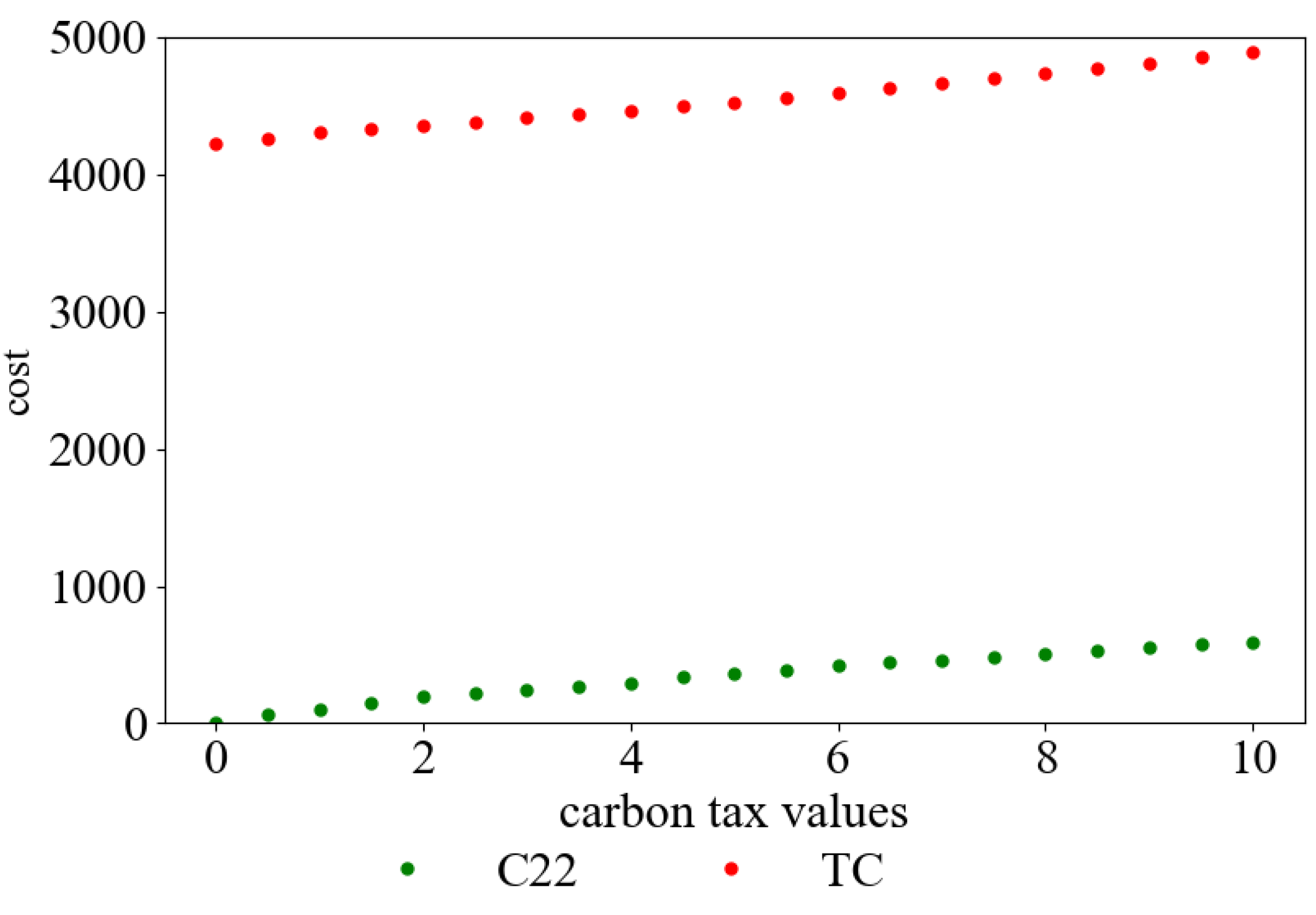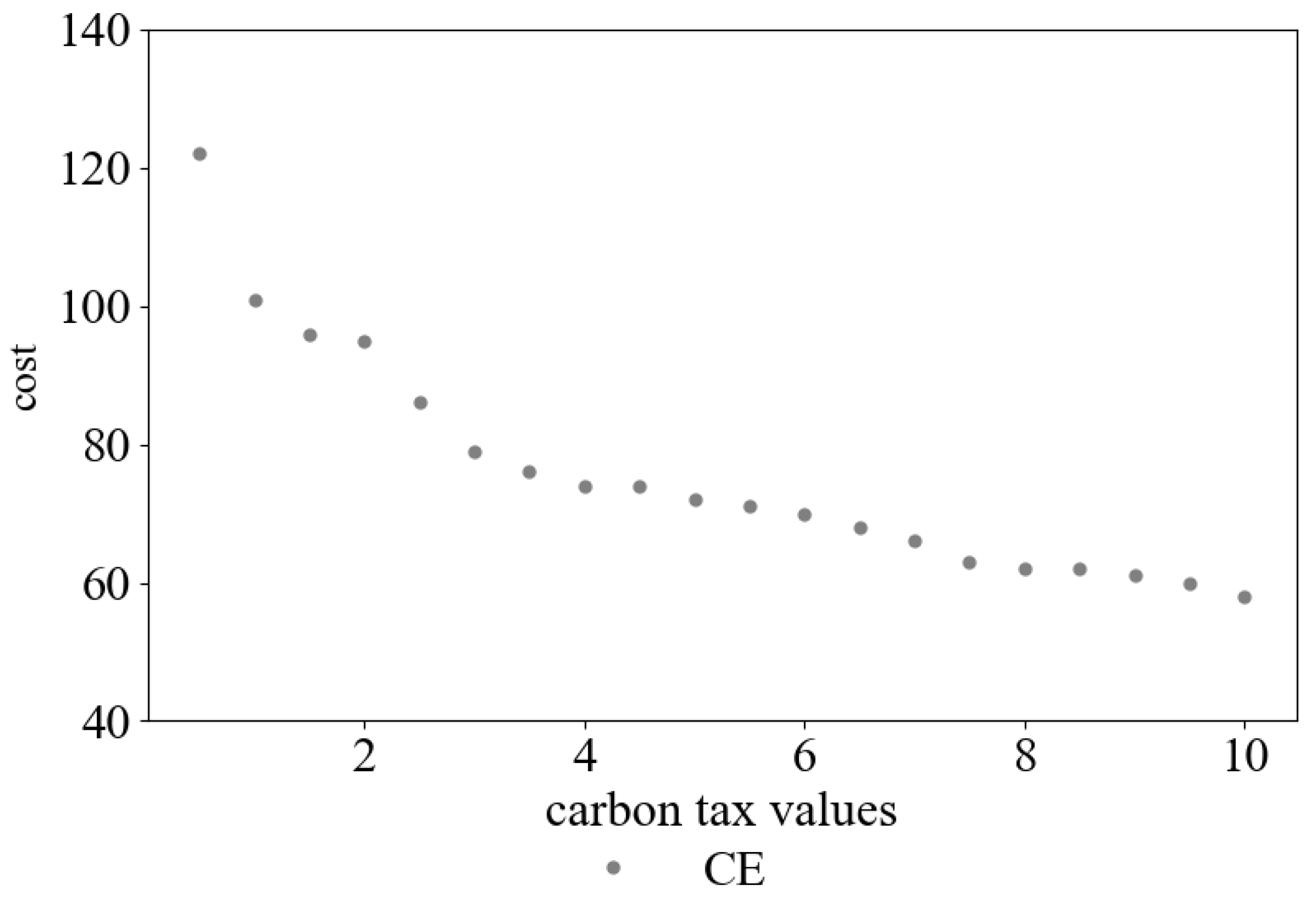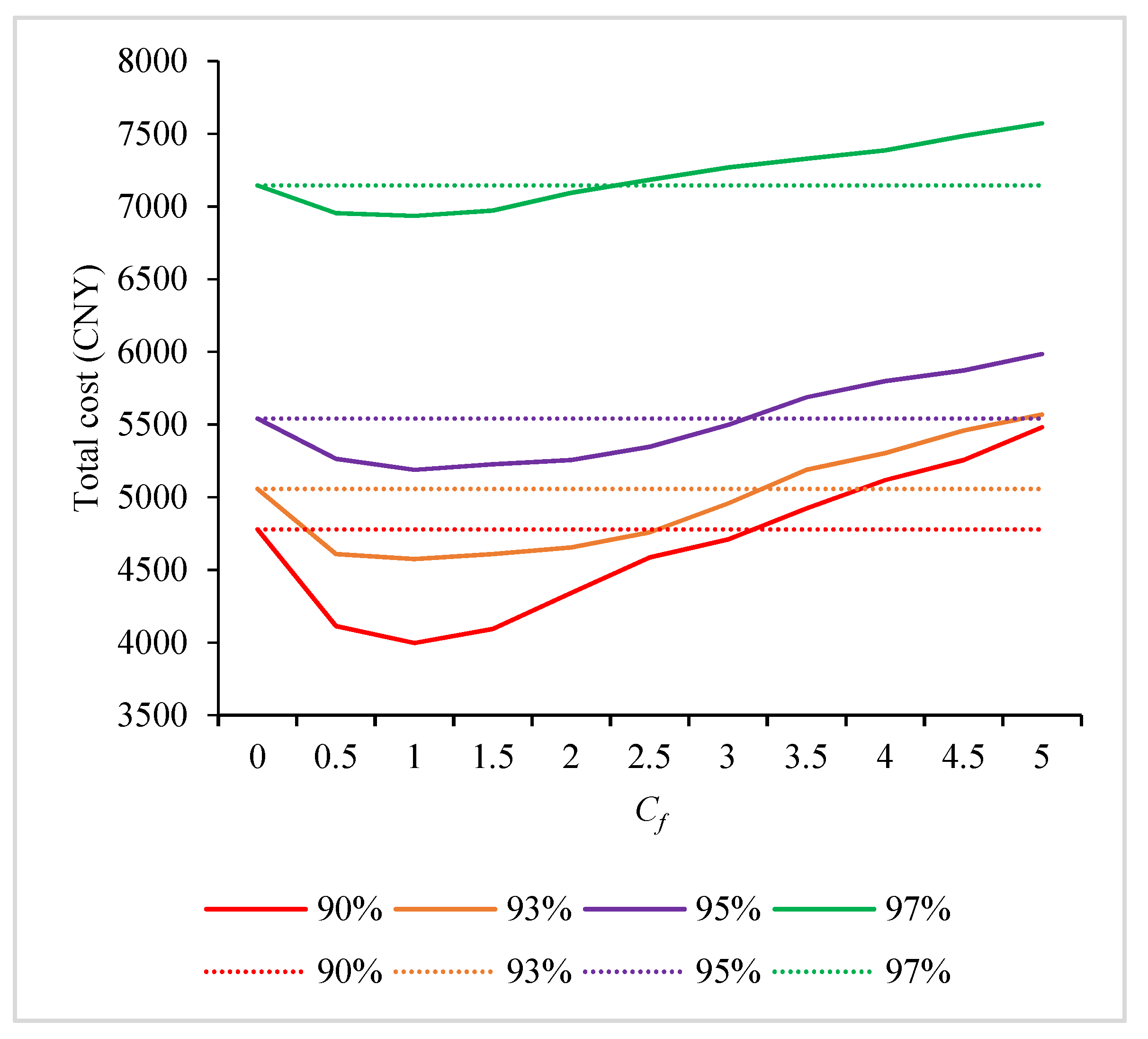Green Vehicle-Routing Problem of Fresh Agricultural Products Considering Carbon Emission
Abstract
:1. Introduction
2. Problem Description and Model Formula
2.1. Problem Description
- (1)
- The distribution center has a sufficient number of vehicles of the same type. The maximum load of all the vehicles is determined.
- (2)
- The demand of each customer is less than the maximum load of the vehicle, and it is only satisfied by one vehicle.
- (3)
- The coordinates, demand, time window and service time of each customer are known. The distance between any two customers is calculated by the straight-line distance. The customers have certain freshness constraints for the fresh agricultural products they need.
- (4)
- The vehicles are allowed to arrive earlier or later than the time window required by the customers, but the companies need to pay the penalty cost.
- (5)
- The vehicles only provide distribution services for fresh agricultural products, including driving and unloading.
- (6)
- There is no significant difference in the driving skills and operating proficiency of all the drivers, and the influences of subjective factors on vehicle speed and fuel consumption are not considered.
2.2. Symbol Definitions
- (1)
- Decision variables
- (2)
- Parameters
2.3. Relevant Parameters
2.3.1. Changes in Freshness
2.3.2. Selection of Vehicle
2.4. Component of Total Cost
2.4.1. Fixed Cost (C1)
2.4.2. Fuel Consumption Cost and Carbon Emission Cost (C2)
2.4.3. Refrigeration Cost and Freshness-Keeping Cost (C3)
2.4.4. Cargo Damage Cost (C4)
2.4.5. Penalty Cost (C5)
2.5. Model Formula
- (1)
- Objective function
- (2)
- Constraints
3. Improved Ant-Colony Optimization (IACO) Design
3.1. Heuristic Factor Design
3.2. State-Transition Strategy
3.3. Pheromone-Updating Mechanism
3.4. The Pseudo-Code Framework Diagram of IACO
| Algorithm 1. IACO for the Model |
|
(i) Input: each customer’s coordinates, demand, time window, service time, etc. (ii) Output: best routine (BR), each part of the minimal total cost (PMIN) and the minimal total cost (MIN). (1) Set N, T[k], F(d), NCmax, NC, etc. (2) Set m as the number of the ants. (3) NC = 1 (4) while NC ≠ NCmax (5) Initialize the ant path and the pheromone of each path. Insert 0 into T[k]. All ants return to the distribution center. (6) for k = 1: m (7) while N ≠ ϕ (8) Select next customer i according to decision-making conditions. Calculate the cargo weight Q(k) and the freshness F(k) if ant k arrives at customer i. (9) if Q(k) ≤ Q and F(k) ≥ F(d) (10) Insert customer i into T[k], delete i from N. (11) else (12) Ant k returns to the distribution center. Insert 0 into T[k]. Q(k) = 0, F(k) = 100%. (13) end if (14) end while (15) end for (16) Calculate the total cost according to T[k]. Select the best routine (BRn), each part of the minimal total cost (PMINn) and the minimal total cost for this iteration (MINn). (17) Update the pheromone of each path according to the best routine. (18) if MINn < MIN (19) MIN = MINn. BR = BRn. PMIN = PMINn. (20) end if (21) NC = NC + 1 (22) end while (23) return BR, PMIN, MIN |
4. Experiments and Results
4.1. Example and Parameter Setting
4.2. Effect of Carbon Tax on Carbon Emission
4.3. Effect of Freshness-Keeping Cost on CE and TC
4.4. Effectiveness Analysis of the IACO
5. Conclusions
Author Contributions
Funding
Institutional Review Board Statement
Informed Consent Statement
Data Availability Statement
Conflicts of Interest
References
- Lacis, A.A.; Schmidt, G.A.; Rind, D.; Ruedy, R.A. Atmospheric CO2: Principal control knob governing Earth’s temperature. Science 2010, 330, 356–359. [Google Scholar] [CrossRef] [PubMed] [Green Version]
- IPCC. Climate Change 2014: Synthesis Report; Cambridge University Press: London, UK, 2014. [Google Scholar]
- Devapriya, P.; Ferrell, W.; Geismar, N. Integrated production and distribution scheduling with a perishable product. Eur. J. Oper. Res. 2017, 259, 906–916. [Google Scholar] [CrossRef]
- Wang, S.; Tao, F.; Shi, Y. Optimization of location–routing problem for cold chain logistics considering carbon footprint. Int. J. Environ. Res. Public Health 2018, 15, 86. [Google Scholar] [CrossRef] [PubMed] [Green Version]
- Chen, L.; Liu, Y.; Langevin, A. A multi-compartment vehicle routing problem in cold-chain distribution. Comput. Oper. Res. 2019, 111, 58–66. [Google Scholar] [CrossRef]
- Zhao, Z.; Li, X.; Zhou, X. Distribution route optimization for electric vehicles in urban cold chain logistics for fresh products under time-varying traffic conditions. Math. Probl. Eng. 2020, 2020, 9864935. [Google Scholar] [CrossRef]
- Hsiao, Y.H.; Chen, M.C.; Chin, C.L. Distribution planning for perishable foods in cold chains with quality concerns: Formulation and solution procedure. Trends Food Sci. Technol. 2017, 61, 80–93. [Google Scholar] [CrossRef]
- Tsang, Y.P.; Choy, K.L.; Wu, C.H.; Ho, G.T.S.; Tang, V. An intelligent model for assuring food quality in managing a multi-temperature food distribution center. Food Control. 2018, 90, 81–97. [Google Scholar] [CrossRef]
- Bogataj, D.; Bogataj, M.; Hudoklin, D. Mitigating risks of perishable products in the cyber-physical systems based on the extended MRP model. Int. J. Prod. Econ. 2017, 193, 51–62. [Google Scholar] [CrossRef]
- Wei, C.; Gao, W.W.; Zhu, Z.H.; Yin, Y.Q.; Pan, S.D. Assigning customer-dependent travel time limits to routes in a cold-chain inventory routing problem. Comput. Ind. Eng. 2019, 133, 275–291. [Google Scholar] [CrossRef]
- Li, Y.; Lim, M.K.; Tseng, M.L. A green vehicle routing model based on modified particle swarm optimization for cold chain logistics. Ind. Manag. Data Syst. 2019, 119, 473–494. [Google Scholar] [CrossRef]
- Qin, G.; Tao, F.; Li, L. A vehicle routing optimization problem for cold chain logistics considering customer satisfaction and carbon emissions. Int. J. Environ. Res. Public Health 2019, 16, 576. [Google Scholar] [CrossRef] [Green Version]
- Babagolzadeh, M.; Shrestha, A.; Abbasi, B.; Zhang, Y.; Zhang, A. Sustainable cold supply chain management under demand uncertainty and carbon tax regulation. Transp. Res. Part. D Transport. Environ. 2020, 80, 102245. [Google Scholar] [CrossRef]
- Wang, S.; Tao, F.; Shi, Y.; Wen, H. Optimization of Vehicle Routing Problem with Time Windows for Cold Chain Logistics Based on Carbon Tax. Sustainability 2017, 9, 694. [Google Scholar] [CrossRef] [Green Version]
- Leng, L.; Zhang, C.; Zhao, Y.; Wang, W.; Zhang, J.; Li, G. Biobjective low-carbon location-routing problem for cold chain logistics: Formulation and heuristic approaches. J. Clean. Prod. 2020, 273, 122801. [Google Scholar] [CrossRef]
- Liu, G.; Hu, J.; Yang, Y.; Xia, S.; Lim, M.K. Vehicle routing problem in cold Chain logistics: A joint distribution model with carbon trading mechanisms. Resour. Conserv. Recycl. 2020, 156, 104715. [Google Scholar] [CrossRef]
- Dantzig, G.B.; Ramser, J.H. The truck dispatching problem. Manag. Sci. 1959, 6, 80–91. [Google Scholar] [CrossRef]
- Braekers, K.; Ramaekers, K.; Nieuwenhuyse, I.V. The vehicle routing problem: State of the art classification and review. Comput. Ind. Eng. 2016, 99, 300–313. [Google Scholar] [CrossRef]
- Islam, M.A.; Gajpal, Y. Optimization of conventional and green vehicles composition under carbon emission cap. Sustainability 2021, 13, 6940. [Google Scholar] [CrossRef]
- Zhang, S.; Gajpal, Y.; Appadoo, S.S.; Abdulkader, M.M.S. Electric vehicle routing problem with recharging stations for minimizing energy consumption. Int. J. Prod. Econ. 2018, 203, 404–413. [Google Scholar] [CrossRef]
- Zhang, H.; Zhang, Q.; Ma, L.; Zhang, Z.; Liu, Y. A hybrid ant colony optimization optimization for a multi-objective vehicle routing problem with flexible time windows. Inf. Sci. 2019, 490, 166–190. [Google Scholar] [CrossRef]
- Li, J.; Wang, F.; He, Y. Electric vehicle routing problem with battery swapping considering energy consumption and carbon emissions. Sustainability 2020, 12, 10537. [Google Scholar] [CrossRef]
- Abbasi, M.; Rafiee, M.; Khosravi, M.R.; Jolfaei, A.; Menon, V.G.; Koushyar, J.M. An efficient parallel genetic optimization solution for vehicle routing problem in cloud implementation of the intelligent transportation systems. J. Cloud Comput. 2020, 9, 6. [Google Scholar] [CrossRef]
- Gmira, M.; Gendreau, M.; Lodi, A.; Potvin, J.Y. Tabu search for the time-dependent vehicle routing problem with time windows on a road network. Eur. J. Oper. Res. 2021, 288, 129–140. [Google Scholar] [CrossRef]
- Lai, D.S.W.; Demirag, O.C.; Leung, J.M.Y. A tabu search heuristic for the heterogeneous vehicle routing problem on a multigraph. Transp. Res. Part. E Logist. Transp. Rev. 2016, 86, 32–52. [Google Scholar] [CrossRef]
- Wei, L.; Zhang, Z.; Zhang, D.; Leung, S.C.H. A simulated annealing optimization for the capacitated vehicle routing problem with two-dimensional loading constraints. Eur. J. Oper. Res. 2019, 265, 843–859. [Google Scholar] [CrossRef]
- Yahyaoui, H.; Kaabachi, I.; Krichen, S.; Dekdouk, A. Two metaheuristic approaches for solving the multi-compartment vehicle routing problem. Oper. Res. 2018, 20, 2085–2108. [Google Scholar] [CrossRef] [Green Version]
- Zhang, D.; Xu, W.; Ji, B.; Li, S.; Liu, Y. An adaptive tabu search optimization embedded with iterated local search and route elimination for the bike repositioning and recycling problem. Comput. Oper. Res. 2020, 123, 105035. [Google Scholar] [CrossRef]
- Marinakis, Y.; Marinaki, M.; Migdalas, A. A multi-adaptive particle swarm optimization for the vehicle routing problem with time windows. Inf. Sci. 2019, 481, 311–329. [Google Scholar] [CrossRef]
- Eskandarpour, M.; Ouelhadj, D.; Hatami, S.; Juan, A.A.; Khosravi, B. Enhanced multi-directional local search for the bi-objective heterogeneous vehicle routing problem with multiple driving ranges. Eur. J. Oper. Res. 2019, 277, 479–491. [Google Scholar] [CrossRef]
- Kitjacharoenchai, P.; Min, B.C.; Lee, S. Two echelon vehicle routing problem with drones in last mile delivery. Int. J. Prod. Econ. 2020, 225, 107598. [Google Scholar] [CrossRef]
- Chen, S.M.; Chien, C.Y. Solving the traveling salesman problem based on the genetic simulated annealing ant colony system with particle swarm optimization techniques. Expert Syst. Appl. 2011, 38, 14439–14450. [Google Scholar] [CrossRef]
- Deng, W.; Xu, J.; Zhao, H. An improved ant colony optimization based on hybrid strategies for scheduling problem. IEEE Access. 2019, 7, 20281–20292. [Google Scholar] [CrossRef]
- Ajeil, F.H.; Ibraheem, I.K.; Azar, A.T.; Humaidi, A.J. Grid-based mobile robot path planning using aging-based ant colony optimization in static and dynamic environments. Sensors 2020, 20, 1880. [Google Scholar] [CrossRef] [PubMed] [Green Version]
- Liu, X.F.; Zhan, Z.H.; Deng, J.D.; Li, Y.; Gu, T.; Zhang, J. An energy efficient ant colony system for virtual machine placement in cloud computing. IEEE Trans. Evol. Comput. 2018, 22, 113–128. [Google Scholar] [CrossRef] [Green Version]
- Chen, J.; Dong, M.; Xu, L. A perishable product shipment consolidation model considering freshness-keeping effort. Transp. Res. Part. E Logist. Transp. Rev. 2018, 115, 56–86. [Google Scholar] [CrossRef]
- Xiao, Y.; Zhao, Q.; Kaku, I.; Xu, Y. Development of a fuel consumption optimization model for the capacitated vehicle routing problem. Comput. Oper. Res. 2012, 39, 1419–1431. [Google Scholar] [CrossRef]
- Ottmar, R.D. Wildland fire emissions, carbon, and climate: Modeling fuel consumption. For. Ecol. Manag. 2014, 317, 41–50. [Google Scholar] [CrossRef]
- Martin, D.; Jacqus, D.; Marius, S. A new optimization algorithm for the vehicle routing problem with time windows. Oper. Res. 1992, 40, 342–354. [Google Scholar] [CrossRef] [Green Version]




| Parameter | Value | Parameter | Value | Parameter | Value |
|---|---|---|---|---|---|
| fk | 200 CNY/veh | cfuel | 5.41 CNY/L | Qm | 100 |
| Q | 2000 kg | η1 | 0.01 | α | 1 |
| P | 12 CNY/kg | η2 | 0.02 | β | 3 |
| ω | 2.669 kg/L | ε1 | 10 CNY/h | q0 | 0.6 |
| a | 5 CNY/h | ε2 | 10 CNY/h | NCmax | 100 |
| b | 12 CNY/h | ρ0 | 0.165 L/km | M | 35 |
| υ (CNY/kg) | C22 | TC (CNY) | CE (kilograms) |
|---|---|---|---|
| 0.00 | 0 | 4223 | 0 |
| 0.25 | 33 | 4243 | 132 |
| 0.50 | 62 | 4264 | 122 |
| 0.75 | 88 | 4286 | 117 |
| 1.00 | 101 | 4309 | 101 |
| 1.50 | 144 | 4333 | 96 |
| 2.00 | 191 | 4358 | 95 |
| 2.50 | 216 | 4384 | 86 |
| 3.00 | 238 | 4411 | 79 |
| 3.50 | 266 | 4439 | 76 |
| 4.00 | 297 | 4468 | 74 |
| 4.50 | 334 | 4498 | 74 |
| 5.00 | 362 | 4529 | 72 |
| 5.50 | 391 | 4561 | 71 |
| 6.00 | 423 | 4594 | 70 |
| 6.50 | 448 | 4628 | 68 |
| 7.00 | 463 | 4663 | 66 |
| 7.50 | 479 | 4699 | 63 |
| 8.00 | 501 | 4736 | 62 |
| 8.50 | 529 | 4774 | 62 |
| 9.00 | 556 | 4813 | 61 |
| 9.50 | 576 | 4853 | 60 |
| 10.00 | 584 | 4894 | 58 |
| Freshness Constraint | Cf | TC | CE |
|---|---|---|---|
| 90% | 0.0 | 4778 | 56 |
| 0.5 | 4113 | 52 | |
| 1.0 | 3996 | 51 | |
| 93% | 0.0 | 5056 | 69 |
| 0.5 | 4609 | 63 | |
| 1.0 | 4575 | 60 | |
| 95% | 0.0 | 5541 | 92 |
| 0.5 | 5263 | 85 | |
| 1.0 | 5188 | 82 | |
| 97% | 0.0 | 7144 | 121 |
| 0.5 | 6954 | 108 | |
| 1.0 | 6934 | 104 |
| Freshness Constraint | Algorithm | TC | C1 and C5 | C2 | C3 | C4 |
|---|---|---|---|---|---|---|
| 90% | IACO | 4113.73 | 1598.82 | 1018.03 | 554.29 | 942.58 |
| ACO | 4484.45 | 1788.42 | 1253.10 | 584.22 | 858.71 | |
| A* | 5219.41 | 1753.06 | 1563.05 | 673.76 | 1429.54 | |
| 95% | IACO | 5263.84 | 3170.29 | 1196.00 | 445.51 | 452.04 |
| ACO | 5384.30 | 3137.36 | 1303.40 | 466.41 | 477.13 | |
| A* | 6350.71 | 3422.56 | 1646.07 | 547.94 | 734.14 |
| Freshness Constraint | Algorithm | Average | Minimum | Maximum | Standard Deviation | Coefficient of Variation |
|---|---|---|---|---|---|---|
| 90% | IACO | 4189.24 | 4113.73 | 4276.35 | 45.40 | 0.0108 |
| ACO | 4616.37 | 4484.15 | 4780.15 | 68.29 | 0.0148 | |
| A* | 5219.41 | 5219.41 | 5219.41 | 0 | 0 | |
| 95% | IACO | 5336.72 | 5263.84 | 5385.50 | 28.66 | 0.0054 |
| ACO | 5509.94 | 5384.30 | 5706.33 | 98.27 | 0.0178 | |
| A* | 6350.71 | 6350.71 | 6350.71 | 0 | 0 |
Publisher’s Note: MDPI stays neutral with regard to jurisdictional claims in published maps and institutional affiliations. |
© 2022 by the authors. Licensee MDPI, Basel, Switzerland. This article is an open access article distributed under the terms and conditions of the Creative Commons Attribution (CC BY) license (https://creativecommons.org/licenses/by/4.0/).
Share and Cite
Yao, Q.; Zhu, S.; Li, Y. Green Vehicle-Routing Problem of Fresh Agricultural Products Considering Carbon Emission. Int. J. Environ. Res. Public Health 2022, 19, 8675. https://doi.org/10.3390/ijerph19148675
Yao Q, Zhu S, Li Y. Green Vehicle-Routing Problem of Fresh Agricultural Products Considering Carbon Emission. International Journal of Environmental Research and Public Health. 2022; 19(14):8675. https://doi.org/10.3390/ijerph19148675
Chicago/Turabian StyleYao, Qi, Shenjun Zhu, and Yanhui Li. 2022. "Green Vehicle-Routing Problem of Fresh Agricultural Products Considering Carbon Emission" International Journal of Environmental Research and Public Health 19, no. 14: 8675. https://doi.org/10.3390/ijerph19148675






